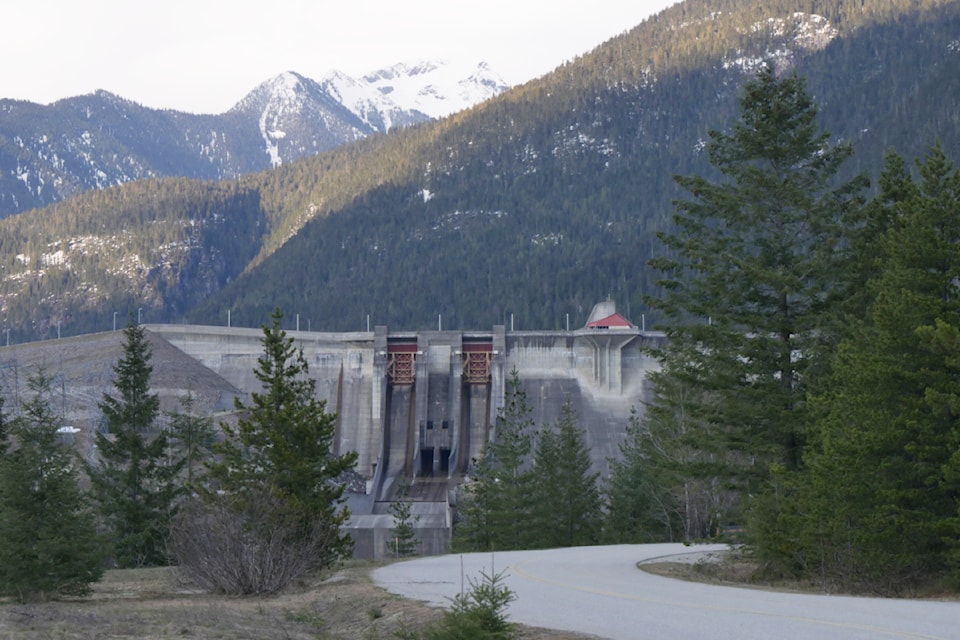While Revelstokians sometimes point to raising the Arrow Lakes Reservoir as a solution to the city's biting bug problem, BC Hydro has answered that this would prove both unfeasible and likely ineffective.
In an email, stakeholder engagement advisor Susan Edgell told Black Press Media that BC Hydro recognizes the public pressure Revelstoke is facing to address mosquito swarms during summer.
"We also know there is a segment of the public that believes that if BC Hydro increased reservoir levels during the peak mosquito months of July and August, it would help control the problem," Edgell said. However, "if recent history is any indication, this would likely ‘not’ solve the problem."
She explained that despite water levels in the Arrow Lakes Reservoir for 2025 being similar to 2023 and 2024, which she said were not considered "bad" years for mosquito activity in Revelstoke, other variables must be at play this year. For example, temperatures, above-average rainfall and aftereffects of two previous years' drought could drive summer 2025's mosquito overpopulation.
A chart provided by BC Hydro indicates that through this summer, reservoir levels have sometimes dropped one or two metres lower than during the same times of year in 2023 and 2024, but other times have remained at equal levels. The water level hasn't dipped below 432 metres above sea level this summer and has peaked at 436 metres, while in 2023 and 2024 it peaked around 439 and 438 metres, respectively.
"It is also important to understand that BC Hydro is unable to unilaterally alter the levels of the reservoir to combat specific year-to-year issues," Edgell said. "BC Hydro does try to operate the reservoir to meet a pre-determined set of soft constraints to help balance a range of interests in the reservoir."
These interests are already often at odds. As per BC Hydro's Water Use Plan, the reservoir is supposed to target between 437 and 439 metres for recreational needs from May 24 to Sept. 30, but in contrast, it should drop levels to 438 metres or below by Aug. 7 to ensure migratory bird habitat is available. Meanwhile, 439 metres is ideal for preventing erosion, and other levels are recommended for fish, vegetation, and cultural and heritage purposes.
As well, BC Hydro remains bound by the Columbia River Treaty to send a pre-determined volume of water to the U.S., "until a new modernized treaty is signed that may change these parameters," Edgell said.
"Add to this we must hold a certain amount of water back to ensure we can meet the power needs of the province during the hot and cold weather seasons," she noted.
Further, BC Hydro points to Ada Jarvis's book 12 Mile Remembered as evidence that Upper Arrow Lake south of town experienced higher mosquito populations before the Revelstoke Dam arrived in the 1970s and '80s.
Chapter 9, pulling on accounts from between 1895 and 1969, tells that due to spring floods, "the Columbia Valley in British Columbia had so many mosquitoes that it was unfit for year-round habitation." Outdoor workers in the small community south of Revelstoke, near Drimmie Creek, reportedly wore neck scarves, bandanas, long-sleeve shirts, ankle-tied pant legs and face netting to evade the insects.
"Mosquitoes crowded on the inside windows, darkening the interiors of barns and other buildings," the chapter reads. "Their little lives could be snuffed out with oily DDT, sprayed from a hand-pumped can. Then the oil and layers of carcasses were wiped off the window panes and sills."
In 1936, other solutions against the swarms included buying "insect powder" from the local drugstore or carrying a smoking mosquito coil from room to room before bedtime until all the bugs dropped dead. A recipe was posted locally in 1925 that entailed mixing citronella, camphor, tar, pennyroyal and castor oil on the hands and face every 30 minutes.
"When BC Hydro Project cleaned out the valley, including the sloughs and backwaters in the 1960s, the mosquitoes' favourite breeding areas were destroyed, which was one of the Project's blessings," the chapter continues. "For several years, there was a noticeable reduction in the insects."
However, it notes that BC Hydro's raising and lowering of the reservoir seemed to have brought the bugs back.
Still, "BC Hydro cannot raise Arrow Lakes Reservoir water levels at any given time," Edgell concluded, and "raising levels would likely not benefit the community when it comes to battling the current mosquito issue."
